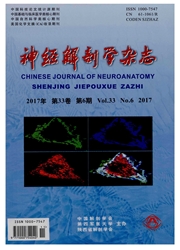

 中文摘要:
中文摘要:
目的:研究不同剂量氯化锂(LiCl)对成年大鼠视神经切断后视网膜神经节细胞(RGCs)存活的作用。方法:眶内切断72只成年雌性SD大鼠左侧视神经且残端留置荧光金(FG)后,随机分为生理盐水对照组和低剂量(30mg/kg/d)、中剂量(60ms/kg/d)、高剂量(85mg/kg/d)氯化锂实验组。术前1d及术后每天腹腔注射生理盐水或不同剂量的氯化锂溶液,直至术后2d、7d或14d处死动物。平铺视网膜后取样计数FG逆行标记的存活节细胞,并由此计算出每一视网膜内节细胞的平均密度。结果:术后2d各剂量氯化锂组节细胞平均密度与对照组相比无显著性差异(P〉0.05)。当存活时间增至7d时,各剂量氯化锂组节细胞密度均明显高于对照组(P〈0.01),且中剂量组节细胞密度增高最为显著。术后14d时,低剂量与中剂量组节细胞密度仍显著高于对照组(P〈0.01),但高剂量组节细胞密度与对照组相比无统计学差异(P〉0.05)。结论:腹腔内注射氯化锂可显著促进成年大鼠视神经切断后节细胞的存活,这种神经保护作用为剂量依赖性。
 英文摘要:
英文摘要:
Objective: To investigate the effect of lithium chloride (LiC1) at three different doses on the survival of retinal ganglion cells (RGCs) after optic nerve (ON) transection in adult rats. Methods: The left ONs of 72 adult female Sprague-Dawley rats were transected intraorbitally and RGCs were retrogradely-labeled with FluoroGold (FG) before they were divided into the saline control and low dose (30 mg/kg/d), medium dose (60 mg/kg./d) and high dose (85 mg/ kg/d) LiC1 groups. The animals received daily intraperitoneal injections of saline or the three different doses of LiC1 one day before ON transection until they were euthanized 2, 7 or 14 days after ON transection. The FG-labeled surviving RGCs were counted in each whole-mounted retina using a sampling method and the mean RGC density was then calculated in each retina. Results: No significant difference ( P 〉 0.05 ) in the RGC density could be detected among the control and three LiC1 experimental groups 2 days after ON transection. When the survival time increased to 7 days, the RGC densities in three LiC1 groups became significantly higher (P 〈 O. 01 ) than that in the control group, with the highest RGC density being in the medium dose group. At the 14'h postoperative day, the densities in the low and medium dose groups remained higher markedly (P 〈 0. O1 ) than that in the control group but the density in the high dose group was similar (P 〉 0.05 ) to that in the control group. Conclusion : Intraperitoneal injections of LiC1 can promote the RGC survival following ON transection in adult rats and such neuroprotection is dose-dependent.
 同期刊论文项目
同期刊论文项目
 同项目期刊论文
同项目期刊论文
 Death of Axotomized Retinal Ganglion Cells Delayed After Intraoptic Nerve Transplantation of Olfacto
Death of Axotomized Retinal Ganglion Cells Delayed After Intraoptic Nerve Transplantation of Olfacto 期刊信息
期刊信息
